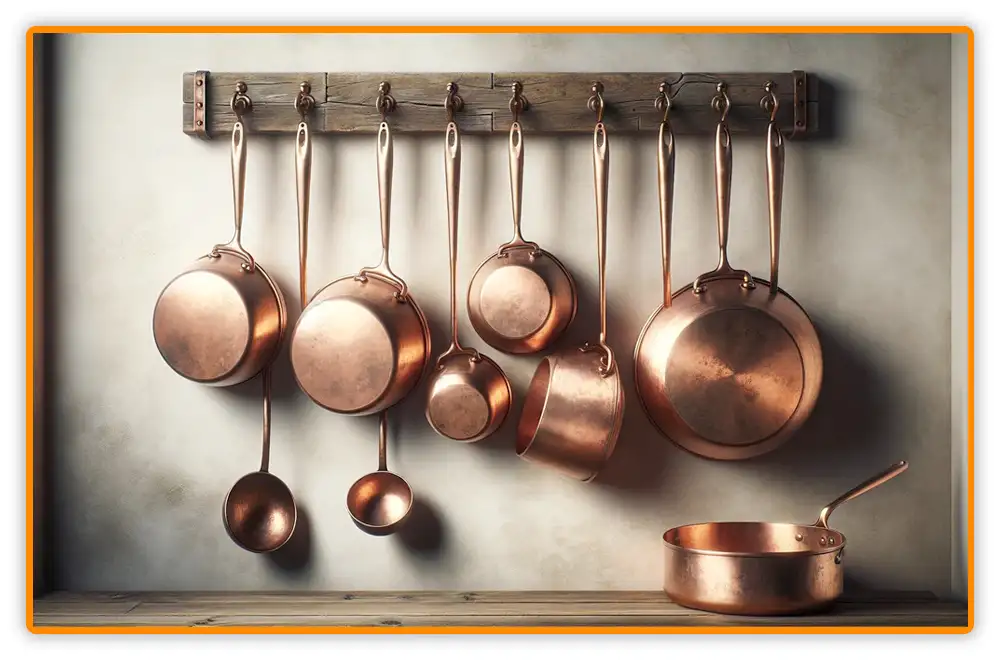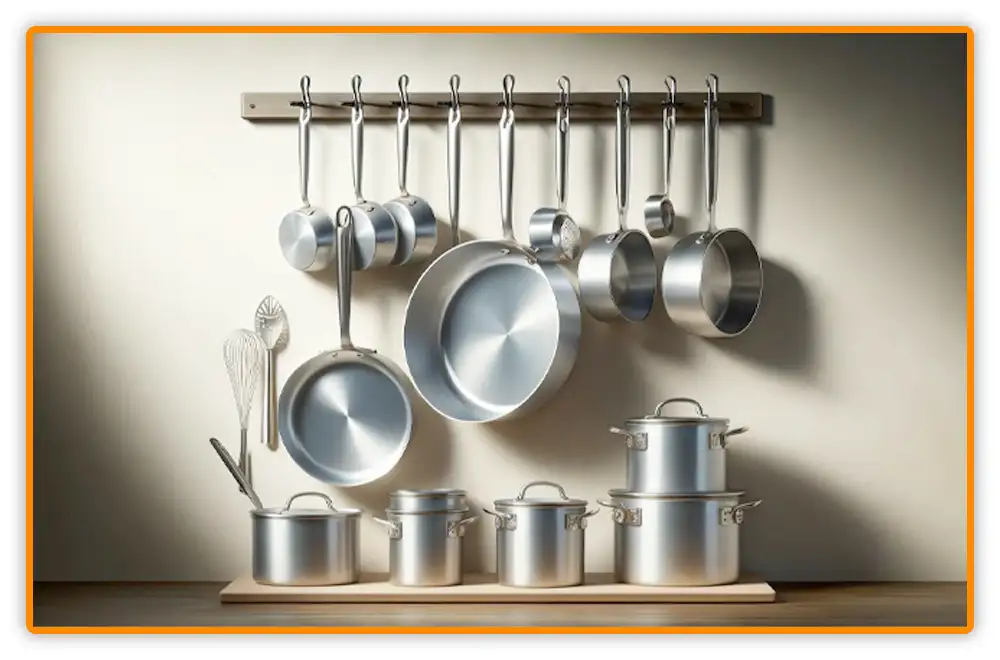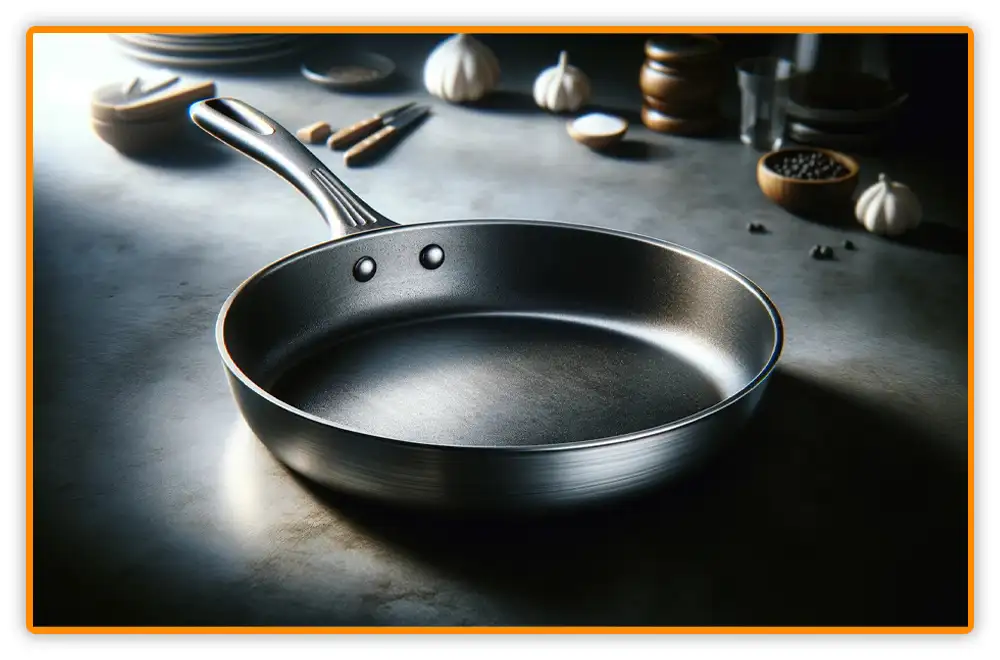Ever stood in your kitchen, staring at your gas stove, wondering if you’re using the right pots and pans? Trust me, I’ve been there. Cooking is an adventure, and choosing the best cookware for gas stoves can be the difference between a perfect meal and a kitchen disaster.
You need cookware that heats evenly and is easy to handle. When I first started cooking, I quickly learned that the right best pots and pans for gas stove can make a world of difference. Let’s explore how to find the perfect set that will make your cooking experience enjoyable and efficient.
Table of Contents
Characteristics of Best Cookware for Gas Stoves
When you’re choosing the best cookware for gas stoves, there are a few key things to keep in mind. Let’s break it down:
Heat Conductivity: This is super important. Good heat conductors, like copper and aluminum, ensure your food cooks evenly. No more burnt spots on one side and raw on the other!
Heat Retention: How long does your cookware stay hot after you turn off the flame? This can really change how your food turns out and can save you energy too. Cast iron, for example, holds heat really well, which is great for slow cooking.
Durability: Gas stoves can be tough on cookware. You need pots and pans that can handle direct flames and high heat without getting damaged. Stainless steel is a champ here.
Non-Reactive Materials: Some cookware materials can change the taste or color of your food. Nobody wants their tomato sauce tasting like metal. Look for non-reactive materials like stainless steel or coated cookware to keep your meals tasting just right.
Choosing the Best Cookware Material for Gas Stoves
Choosing the right pots and pans is key for anyone who loves to cook. Different materials can change how you cook and how your food turns out. Here’s a guide to help you choose wisely.
| Material | Benefits | Limitations | Best For |
| Stainless Steel | Durable, non-reactive, versatile | Poor heat conductor without core | Searing, sautéing, boiling |
| Cast Iron | Great heat retention, non-stick after seasoning | Heavy, requires seasoning | Slow cooking, frying |
| Copper | Top heat conductivity | Expensive, reacts with acidic foods if not lined | Sauces, precise temperature control |
| Aluminum | Lightweight, heats quickly | Reacts with acidic foods, health concerns | Quick, even heating |
| Enamel Cast Iron | Easy maintenance, great heat retention | Heavy, expensive | Casseroles, stews, baking |
| Carbon Steel | Quick temperature response, lightweight | Needs seasoning, can rust | Searing, sautéing, stir-frying |
Stainless Steel Cookware for Gas Stoves
When I first started using stainless steel cookware, I was amazed at how well it performed. Whether I was whipping up light Japanese tempura or a spicy Thai curry, these pans never let me down. But, like any good tool, it has its quirks.

Advantages
- Heat Conductivity: With a core of aluminum or copper, it heats up fast and cooks food evenly. No more hot spots!
- Durability: These pots and pans are built to last. They can handle daily cooking without breaking a sweat.
- Versatility: From browning meat to making delicate sauces, stainless steel can do it all.
- Non-reactive: It doesn’t react with acidic foods, so your flavors stay pure and delicious.
Disadvantages
- Sticking: If not preheated or oiled properly, food can stick. But with a little practice, you’ll master it.
- Maintenance: It needs careful cleaning to keep it looking shiny and new. A little effort goes a long way.
- Weight: Stainless steel can be heavy, making big pots and pans a bit tricky to handle.
Recommended Usage
Stainless steel is perfect for daily cooking. It’s great for searing, sautéing, boiling, and simmering. If you’re looking for the best cookware for gas stoves, stainless steel cookware is a top choice. It lasts, does many things, and looks classic in any kitchen.
Is Stainless Steel Cookware Safe?
Yes, stainless steel cookware is safe for cooking. It doesn’t react with food, so your meals stay true to their flavors.
On rare occasions, especially with low-quality stainless steel or when cooking for long periods at very high temperatures, tiny amounts of nickel or chromium might leach into food.
I’ve relied on my stainless steel pots and pans for years, and they’ve never let me down. For safe and versatile cookware, stainless steel is an excellent option.
Related Post : 5 Ply Stainless Steel Cookware
Cast Iron Cookware for Gas Stoves
Cast iron cookware is like the old friend who’s always there when you need them—reliable and strong. It’s amazing at keeping heat and spreading it evenly. But let’s be real, it’s heavy and needs regular care to stay non-stick. I remember the first time I cooked a Moroccan Tagine in my cast iron cookware, and it was a game-changer.

Advantages
- Heat Retention: Cast iron keeps heat really well. It’s great for slow cooking, braising, and searing. Perfect for dishes like Moroccan Tagine or French Cassoulet.
- Durability: This stuff is built to last. It can be passed down through generations. My grandmother’s cast iron skillet is still going strong!
- Non-stick: After seasoning, it becomes naturally non-stick, making cooking easy without any chemical coatings.
Disadvantages
- Heavy: It can be hard to lift, especially when full of delicious food.
- Maintenance: It needs regular care and seasoning to avoid rust and keep its non-stick surface.
- Reactivity: It might react with acidic foods, changing the flavor or adding iron to your meal.
Recommended Usage
Cast iron is fantastic for slow cooking, stews, braises, and searing. It gives food a special crust that’s hard to beat. If you love traditional cooking and don’t mind a bit of extra work for great food, cast iron cookware is your best bet.
Copper Cookware for Gas Stoves
Copper cookware is like the sports car of the kitchen world—sleek, fast, and a bit high-maintenance. These pots and pans heat up quickly and evenly, which is fantastic for dishes where precise temperature control is key, like sauces and sweets. But let’s dive deeper into what makes copper cookware a great choice for your gas stove.

Advantages
- Heats up Fast: Copper is the best for quick and even heating, making it perfect for delicate foods like chocolate and fish.
- Kills Germs: An interesting perk is that copper naturally kills many germs, which is great for keeping your kitchen clean.
- Looks Good: Let’s face it, copper cookware is shiny and pretty, adding a touch of elegance to your kitchen.
Disadvantages
- Pricey: Copper cookware can be more expensive than other options, but it’s often worth the investment.
- Can Taste Funny: Without proper lining, acidic foods might taste metallic, which isn’t pleasant.
- Needs Care: To keep its good looks, copper needs regular cleaning and polishing.
Recommended Usage
Copper cookware is ideal for chefs who love exact heat control and enjoy having nice-looking pots and pans. It’s perfect for making candy, fine sauces, and foods that need careful cooking. Just be prepared to spend a little extra time on care and maintenance.
I remember the first time I used a copper cookware set to make a delicate chocolate sauce. The even heating was incredible, and the result was silky smooth. Whether you’re looking for the best copper cookware or a complete copper cookware set, these beautiful pieces can be a great addition to your kitchen, provided you’re ready for a bit of extra care.
Is Copper Cookware Safe?
Yes, copper cookware is safe, but it needs a coating of a non-reactive metal such as stainless steel or tin. Uncoated copper can react with acidic foods, which might cause copper to get into your meals. Cookware with this protective layer is not only safe but also fantastic due to its excellent heat conductivity.
When I first used copper pans, I loved how quickly they heated up and how evenly they cooked. I always ensure my copper cookware has this protective coating to avoid any health risks. For safe and efficient cooking, make sure your copper pans have a proper lining.
Aluminum Cookware for Gas Stoves
Aluminum cookware is like the reliable buddy in your kitchen—it’s light, heats up fast, and cooks food evenly. It’s a favorite among many cooks. But it can react with sour or bitter foods, changing their color and taste. Thankfully, anodized aluminum is here to save the day.

Anodized Aluminum: This process makes aluminum stronger and better for cooking. It prevents the pan from reacting with sour foods and helps avoid rust and sticking. Think of it as adding a protective layer to keep your food tasting good.
Advantages
- Cheap: Aluminum cookware is budget-friendly, perfect for those just starting out in the kitchen.
- Heats Evenly: It ensures your food cooks uniformly, avoiding those dreaded hot spots.
- Light: Easy to lift and move around, making it great for daily use.
Disadvantages
- Not Very Tough: Aluminum can bend or get out of shape easily.
- Can React With Food: Sour foods can pick up aluminum from the pan, altering the taste.
- Non-stick Wears Off: Non-stick layers may not last long, but anodized aluminum can help with this issue.
Recommended Usage
Aluminum cookware is ideal for people new to cooking or on a budget. It’s light, easy to handle, and cooks food evenly. For cooking sour foods safely, go for the stronger, anodized type. It’s a fantastic choice if you’re looking for the best pots and pans for gas stove cooking that won’t break the bank.
I remember when I first started cooking, my trusty aluminum pan was my go-to. It heated up quickly, and I could move it around with ease. Over time, I discovered anodized aluminum, and it made a world of difference, especially for those tangy tomato sauces.
Is Aluminum Cookware Safe?
Yes, aluminum cookware is safe for cooking. But plain aluminum can react with sour foods, which might change how they taste. Anodized aluminum is a good choice because it has a protective layer that stops this from happening and makes the pan stronger.
When I first started cooking, I used a basic aluminum pan. It was light, heated up fast, and was easy to move around. Later, I found anodized aluminum, which worked great for cooking things like tomato sauce. For safe and reliable cookware, anodized aluminum is the best bet.
Enamel Cast Iron Cookware for Gas Stoves
Enamel cast iron cookware is a fantastic choice for those who love to cook. It combines the best of old-fashioned cast iron with a special enamel coating, making it easy to clean and maintain. If you enjoy the benefits of cast iron without the extra work, this might be the perfect cookware for you.

Advantages
- Non-Reactive: The enamel coating is safe for all foods, making it ideal for acidic dishes that don’t mix well with plain cast iron.
- Heat Retention: It holds heat exceptionally well, perfect for slow cooking and baking.
- Durable: These pieces are built to last, resisting damage and scratches over time.
- Easy Care: No seasoning required! Cleaning is a breeze, and many items can go in the dishwasher.
Disadvantages
- Heavy: Enamel cast iron can be quite heavy, which might not be suitable for everyone.
- Costly: These items are pricier than plain cast iron due to the enamel process.
- Sensitive to Temperature Changes: Rapid temperature changes can cause the enamel to crack.
Recommended Use
Enamel cast iron is great for slow cooking, such as braising, baking, and stewing. It provides gentle, even heat and is easy to care for, while still offering all the benefits of traditional cast iron.
I remember the first time I used an enamel cast iron cookware set for making a hearty stew. The even heat distribution was remarkable, and cleanup was a breeze. If you’re searching for the best enamel cast iron cookware, this type of cookware delivers excellent performance and durability.
Carbon Steel Cookware for Gas Stoves
Carbon steel cookware is a favorite among chefs for good reason. It heats up fast, handles high heat, and is lighter than cast iron and stainless steel. It warms up quickly and cooks evenly, making it a versatile tool in the kitchen.

Advantages
- Quick Heating: Carbon steel gets hot and cools down fast, allowing you to easily control the heat while cooking.
- Strong: This cookware is tough and great for high-heat cooking in busy kitchens.
- Non-Stick: When seasoned correctly, it becomes naturally non-stick.
- Flexible: You can fry, sear, sauté, and even bake with carbon steel.
Disadvantages
- Care: Regular seasoning is needed to keep it non-stick and rust-free.
- Reacts with Acid: Like cast iron, acidic foods might taste metallic if cooked in it.
Recommended Use
Carbon steel is perfect for frying, searing, and sautéing at high heat. It’s great for both chefs and home cooks who want a lightweight, flexible pan that controls heat well.
I remember the first time I used a carbon steel cookware set for making a quick stir-fry. The pan heated up in no time, and the vegetables cooked evenly with a nice sear. It quickly became one of my go-to pieces in the kitchen. If you’re looking for the best pans for gas stove cooking, carbon steel is an excellent choice.
Is Carbon Steel Cookware Safe?
Yes, carbon steel cookware is safe. It’s very durable and, when seasoned properly, becomes naturally non-stick. Just remember to avoid cooking very acidic foods in it, as they can react with the metal.
I love using my carbon steel pans because they heat up quickly and cook food evenly. With proper care, they last a long time and are a joy to cook with. For a reliable and safe option, carbon steel cookware is a great choice.
Conclusion
Choosing the best cookware for gas stoves is essential for culinary success. It helps you cook tasty food and save energy. Think about how you like to cook, the good and bad sides of each material, and what you need for your cooking. With the best cookware, every meal can turn out great.
If you’re looking for the best cookware for gas stoves and need guidance contact us for expert help.
FAQ
What is the best cookware for gas stoves?
Stainless steel cookware is best for gas stoves. It is strong and cleans easily. It heats up fast and cooks food evenly.
Do you need special pots for gas stove?
No, you don’t need special pots for a gas stove. But, pots made of stainless steel, cast iron, or copper are great. They heat up well and last long. This makes your cooking easier and better.

